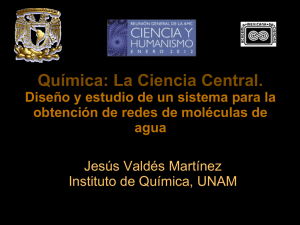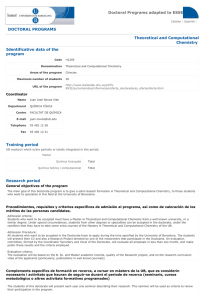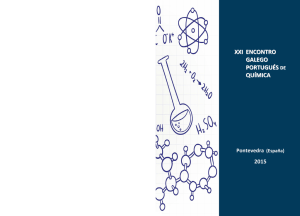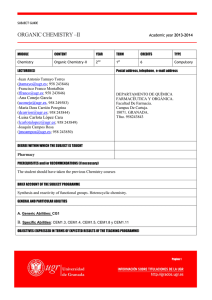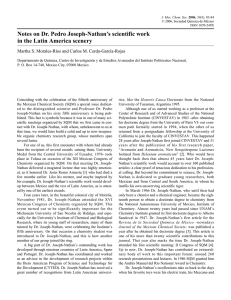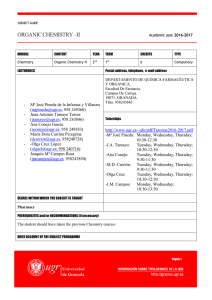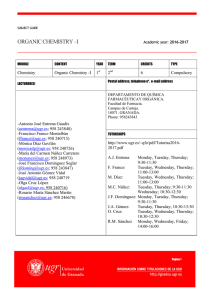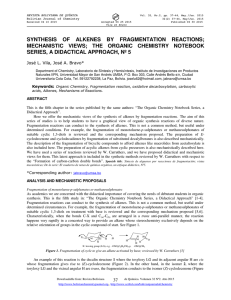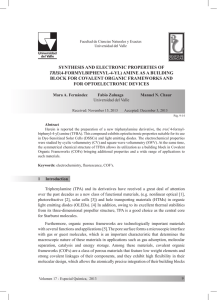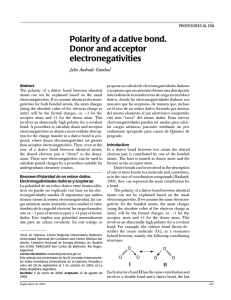educación química
Anuncio
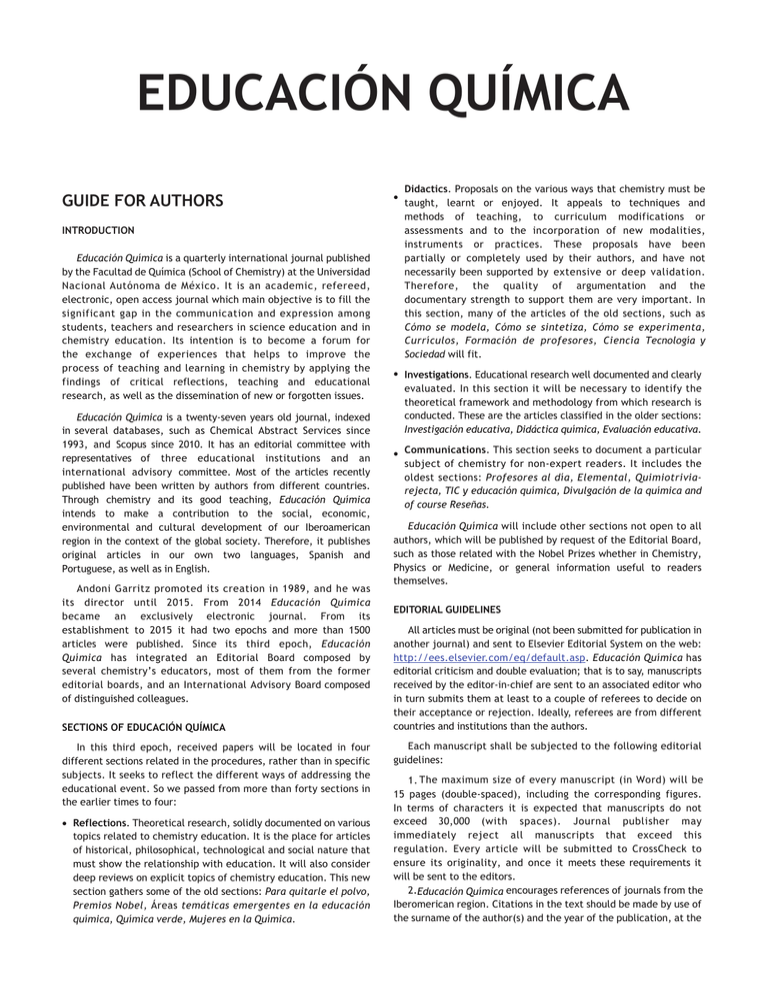
EDUCACIÓN QUÍMICA GUIDE FOR AUTHORS INTRODUCTION Educación Química is a quarterly international journal published by the Facultad de Química (School of Chemistry) at the Universidad Nacional Autónoma de México. It is an academic, refereed, electronic, open access journal which main objective is to fill the significant gap in the communication and expression among students, teachers and researchers in science education and in chemistry education. Its intention is to become a forum for the exchange of experiences that helps to improve the process of teaching and learning in chemistry by applying the findings of critical reflections, teaching and educational research, as well as the dissemination of new or forgotten issues. Educación Química is a twenty-seven years old journal, indexed in several databases, such as Chemical Abstract Services since 1993, and Scopus since 2010. It has an editorial committee with representatives of three educational institutions and an international advisory committee. Most of the articles recently published have been written by authors from different countries. Through chemistry and its good teaching, Educación Química intends to make a contribution to the social, economic, environmental and cultural development of our Iberoamerican region in the context of the global society. Therefore, it publishes original articles in our own two languages, Spanish and Portuguese, as well as in English. Andoni Garritz promoted its creation in 1989, and he was its director until 2015. From 2014 Educación Química became an exclusively electronic journal. From its establishment to 2015 it had two epochs and more than 1500 articles were published. Since its third epoch, Educación Química has integrated an Editorial Board composed by several chemistry’s educators, most of them from the former editorial boards, and an International Advisory Board composed of distinguished colleagues. SECTIONS OF EDUCACIÓN QUÍMICA In this third epoch, received papers will be located in four different sections related in the procedures, rather than in specific subjects. It seeks to reflect the different ways of addressing the educational event. So we passed from more than forty sections in the earlier times to four: • Reflections. Theoretical research, solidly documented on various topics related to chemistry education. It is the place for articles of historical, philosophical, technological and social nature that must show the relationship with education. It will also consider deep reviews on explicit topics of chemistry education. This new section gathers some of the old sections: Para quitarle el polvo, Premios Nobel, Áreas temáticas emergentes en la educación química, Química verde, Mujeres en la Química. • Didactics. Proposals on the various ways that chemistry must be taught, learnt or enjoyed. It appeals to techniques and methods of teaching, to curriculum modifications or assessments and to the incorporation of new modalities, instruments or practices. These proposals have been partially or completely used by their authors, and have not necessarily been supported by extensive or deep validation. Therefore, the quality of argumentation and the documentary strength to support them are very important. In this section, many of the articles of the old sections, such as Cómo se modela, Cómo se sintetiza, Cómo se experimenta, Currículos, Formación de profesores, Ciencia Tecnología y Sociedad will fit. • Investigations. Educational research well documented and clearly evaluated. In this section it will be necessary to identify the theoretical framework and methodology from which research is conducted. These are the articles classified in the older sections: Investigación educativa, Didáctica química, Evaluación educativa. • Communications. This section seeks to document a particular subject of chemistry for non-expert readers. It includes the oldest sections: Profesores al día, Elemental, Quimiotriviarejecta, TIC y educación química, Divulgación de la química and of course Reseñas. Educación Química will include other sections not open to all authors, which will be published by request of the Editorial Board, such as those related with the Nobel Prizes whether in Chemistry, Physics or Medicine, or general information useful to readers themselves. EDITORIAL GUIDELINES All articles must be original (not been submitted for publication in another journal) and sent to Elsevier Editorial System on the web: http://ees.elsevier.com/eq/default.asp. Educación Química has editorial criticism and double evaluation; that is to say, manuscripts received by the editor-in-chief are sent to an associated editor who in turn submits them at least to a couple of referees to decide on their acceptance or rejection. Ideally, referees are from different countries and institutions than the authors. Each manuscript shall be subjected to the following editorial guidelines: 1. The maximum size of every manuscript (in Word) will be 15 pages (double-spaced), including the corresponding figures. In terms of characters it is expected that manuscripts do not exceed 30,000 (with spaces). Journal publisher may immediately reject all manuscripts that exceed this regulation. Every article will be submitted to CrossCheck to ensure its originality, and once it meets these requirements it will be sent to the editors. 2.Educación Química encourages references of journals from the Iberomerican region. Citations in the text should be made by use of the surname of the author(s) and the year of the publication, at the GUIDE FOR AUTHORS appropriate place. When more than one source is cited they should be listed in chronological and then alphabetical order. All references must appear at the end of the manuscript, in strictly alphabetical order; if the same author is cited more than once, it should be done in chronological order. Every reference to a book should follow the order: Author(s) (year of publication). Name of that book (in italics). City, country: publisher. Examples: Heisenberg, W. (1958). Physics and Philosophy. The Revolution in Modern Science. Nueva York, USA: Harper Torch Books. Latour, B. (2007). Nunca fuimos modernos. Ensayo de antropología simétrica. Buenos Aires, Argentina: Siglo Veintiuno. Every reference to an article should follow the order: Author(s) (year of publication). Article’s name. Full name of the journal (in italics), volume (in italics) number in brackets (if any), initial and final page of the article. Examples: Cardoso, N. Chaparro, N. y Erazo, E. (2006). Una revisión sobre la naturaleza de las concepciones de ciencia. Itinerantes, 4, 95-101. Szabadváry, F. and Oesper, E. E. (1964). Development of the pH concept. Journal of Chemical Education, 41(2), 105-107. Quotations from book chapters should follow the following order: author (s) (year of publication). Name of the chapter of that book, “in” or “en” editor (s), name of that book (in italics), (pp. pages in which it appears.). City, country: publisher. Examples: Driver, R.(1985). Beyond Appearances: The Conservation of Matter under Physical and Chemical Transformations, in Driver R., Guesne, E., Tieberghien, A. (editors), Children’s ideas in science, (pp. 145-169). Milton Keynes, Philadel- phia, U.S.A: Open University Press. Martínez, S. (2005). Constructivismo y filosofía de la educación, en Martínez, S. y Guillaumin, G. (comps.), Historia, filosofía y enseñanza de la ciencia, (pp. 401-417). México: UNAM, Instituto de Investigaciones Filosóficas. Brooke, J. H. (1995). Avogadro’s hypothesis and its fate: a case– study in the failure of case–studies. In: Brooke, J. H. (editor), Thinking about matter. Studies in the history of chemical philosophy, (pp. 235-273). Great Yarmouth, UK: Varorium. Electronic references follow the format of the American Psychology Association (APA), given at the following address: http: //www.apastyle.org/elecref.html. Examples: Kind, V., Beyond Appearances: Students’ misconceptions about basic chemical ideas, A report prepared for the Royal Society of Chemistry, Second edition, 2004, consulted in October 24th, 2012, in URL: http://www.rsc.org/images/Misconceptions_upda te_tcm18-188603.pdf Chemical Heritage Foundation, consulted in October 24th, 2012, in URL http://www.chemheritage. org/ Footnotes should be only for clarification, they will only serve to expand or illustrate what was said in the body of the text. 3. The language used should be simple and straightforward, avoiding long paragraphs. 4. When it is necessary to use a technical name or a word that only makes sense for those who master the language of science, its meaning should be clarified in the simplest way. 5. Articles will be accompanied by all figures as originals ready for insertion into journal. The author has to take into account that the size of the letters in the original is large enough not to become unreadable after reduction. In case of needing already published material from other sources, permission must be obtained by the author. 6. Articles from any industry referring to some technical or industrial interest problem must come officially accredited by it. If they are the responsibility of the authors, this should be clearly stated. CRITERIA FOR REFEREEING It is desirable that authors know the criteria used by the referees during the evaluation process. Editors agree to judge manuscripts in accordance with the following guidelines: i. Is the subject of the article relevant? Will it improve chemical education in the region? It is indicated how reading the article may do so? ii. Is the aim of the work explicitly manifested? Is the question that the paper tries to solve or the goal that it aims to develop significant? Are they fully justified? iii. Is it well written? Can it be easily read? Is each step justified? Is it properly illustrated? Is the argument conclusive? iv. In case the manuscript is qualitative or quantitative field research, are theoretical framework and methodology from which it is made identified? Are definition of the sample, statistical validity, techniques and method of analysis appropriate? v. Is there rigor, relevance and originality in the conclusions? Are they a consequence of the development of the article? Are predictable conclusions obtained from the beginning? Are there innovations? Are further reflections, didactics or investigations clearly recognized? vi.Does the manuscript include a review of the literature relevant to the topic and does it state clearly the way(s) the study contributes to our knowledge? Are references of journals from the Iberomerican region incorporated? Based on the above, the referees will recommend one of the following options: A. Acceptance. B. Conditional acceptance to making small changes. C. Acceptance conditional on the implementation of major changes. D. Rejection of the article but with the suggestion to submit again to evaluation in the next six months. E. Final rejection of the article. In the second and third cases, issues that will be deleted, corrected or added must be explicitly mentioned. In the fourth case, the referee will issue a justification based on failure to comply with any of the established criteria. The Editorial Board shall settle any discrepancy between referees.
